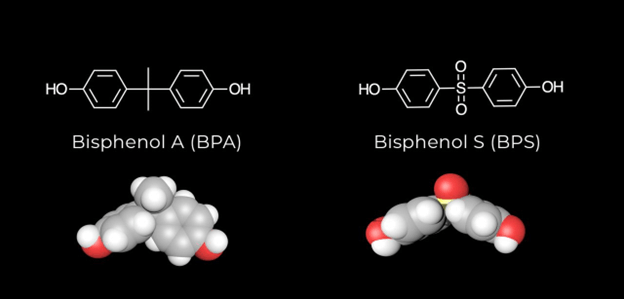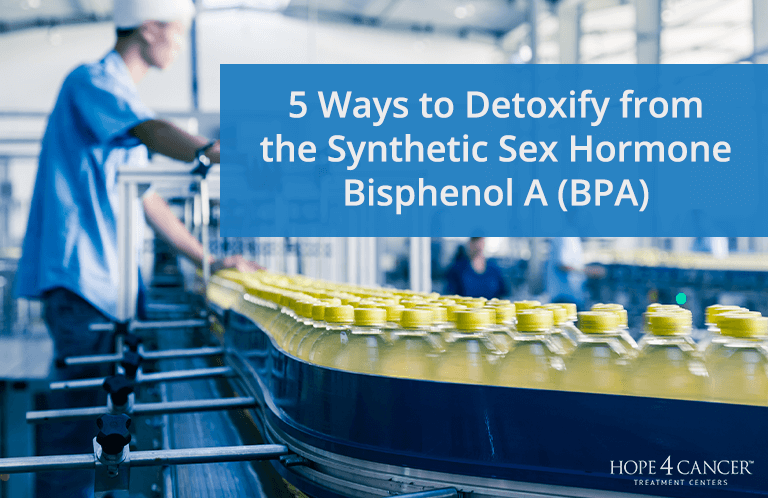Summary:
- Recognizing and avoiding BPA is key to eliminating it from the body
- In addition to plastic containers and water bottles, BPA is found in unlikely places, such as printed receipts and dental fillings
- BPA can be eliminated by supporting liver detoxification and cultivating a healthy microbiome with organic foods, antioxidants, and specific supplements
- Research shows that BPA is excreted in sweat—exercise, sauna therapy, and adequate water intake support this pathway
In our previous blog article, we discussed the history of the chemical BPA and its connection with a wide range of health conditions and chronic diseases. It’s almost unfathomable how a chemical once studied as a synthetic estrogen has become so ubiquitous in our world. Its presence in our bodies is even more egregious considering we had no knowledge of its presence in the first place! Fortunately, there are several strategies we can utilize to avoid and detoxify from BPA. Rooted in science, these strategies can rid our bodies of toxic chemicals, promote a healthy lifestyle, and even lessen our risk of developing cancer!
Strategy 1: Recognize the Sources and Avoid Them!
The first step of detoxifying from BPA is recognition and avoidance. After all, every detoxification strategy in the world won’t help if we’re continually re-exposed to the toxin. BPA can enter the body in 3 ways—ingestion, inhalation, or absorption through the skin—but exposure to BPA most frequently occurs through contact with food and water. Common sources of BPA exposure include disposable and reusable water bottles, plastic food containers, and metal cans.

Figure 1. Tips to avoid BPA in food and water.
The following are helpful tips for avoiding BPA in food and water (Figure 1):
- Look for BPA-free labels and packaging.
- Instead of plastic, use glass and stainless steel when possible.
- Never heat or microwave plastic.
- Discard old or damaged plastic containers.
- Avoid recycling codes 3 & 7 as these typically contain BPA.
- Consume less canned foods and more fresh, organic foods.
We are also exposed to BPA in surprising places, like printed receipts and dental fillings! Thermal receipts are frequently used in the United States and contain high amounts of BPA. While receipts seem pretty harmless, according to a study performed in 2014, the exposure to BPA from these receipts is 1,000 times higher than from canned food (BPA, 2010)! In fact, workers who frequently handle receipts have higher levels of BPA in their bodies compared to those who don’t (Zalko et al., 2011). For this reason, thermal receipts were banned in Europe in 2020. When possible, request digital or email receipts and wash your hands with soap and water after handling them.
Dental sealants can also contain chemical compounds that turn to BPA when in contact with saliva. It can be difficult to avoid this risk since manufacturers don’t have to disclose the components of their sealants. Still, most of the BPA in these sealants can be neutralized by scrubbing and rinsing immediately after application. For this reason, working with a biological dentist who is knowledgeable about dental toxins can help mitigate this risk.

Figure 2. Comparison of 2D and 3D structures of BPA (left) and BPS (right). BPS is being used by companies to replace BPA—however, this doesn’t resolve the adverse health outcomes because these two compounds behave very similarly in the body given their nearly identical structures.
Unfortunately, many companies and products claiming to be BPA-free instead use a similar compound, such as BPS (Figure 2). While almost identical compounds, BPS is even more toxic to the reproductive system and has the same risk of promoting breast cancer, obesity, and metabolic disorders as BPA (Thoene et al., 2020). Some companies such as General Mills claim to be BPA-free but then refuse to state which compound they use in place of BPA, raising the question of whether they simply replaced BPA for BPS.
Strategy 2: Strengthen Yourself with Quality Nutrition
It is difficult to trust the safety of commercial products, given that big corporations are strategically ambiguous regarding their ingredients. That is why following the Garden Food Plan™ (which includes safe cooking techniques) is the most effective way to drastically reduce our intake of BPA from food and water. Based on foods our body is built to eat, this nutritional plan is primarily vegetarian and gluten-free, with plenty of organic fruits, vegetables, nuts, and seeds. It’s free from processed foods and refined sugars and, because it’s centered around fresh, natural, and organic foods, it’s free from plastic contamination. The Garden Food Plan is a wonderful nutritional foundation for preventing and fighting cancer, as well as eliminating toxic chemicals like BPA!
Another benefit of adopting a healthy nutritional plan is the cultivation of a healthy microbiome. A balanced microbiome can assist in the breakdown of toxins, making it an essential focus when trying to eliminate BPA. Taking a high-quality probiotic and eating foods such as sauerkraut, asparagus, pineapple, kimchi, and apple cider vinegar can support a healthy microbiome.
Emerging research shows promising results with antioxidants, as well. In one study performed at Harvard Medical School, researchers were able to reverse the reproductive damage caused by BPA simply by administering an antioxidant called coenzyme Q10 (Hornos Carneiro et al., 2020). This antioxidant is found naturally in meat, fish, and nuts and is also available as a supplement. As always, consult a knowledgeable physician before starting any new supplements as these can interact with medications and treatment.
BPA is broken down in the liver by a process called glucuronidation (Street et al., 2017). One way to assist the body in detoxifying BPA is by eating foods that support this specific process. These foods include cruciferous vegetables (such as kale, broccoli, and cauliflower), red grapes, and citrus fruits (such as oranges and lemons). Curcumin, rooibos tea, honeybush tea, and rosemary also support glucuronidation (Hodges & Minich, 2015).
Because of its crucial role in BPA detoxification, it’s also important to support and detoxify the liver. One excellent liver detoxifying strategy is with coffee enemas. By stimulating the detox pathways in our primary detoxification organ, we can aid the body in the elimination of BPA and other toxins. Coffee enemas have a multitude of other benefits as well, including enhanced energy, improved mood, pain relief, and increased relaxation. Many integrative physicians recommend 2-3 coffee enemas a week for health maintenance.
Strategy 3: Detoxification Through Exercise
Other research shows that the body excretes BPA via sweat. Interestingly, the study that showed promising results with BPA excretion in sweat also found BPA in the sweat of individuals whose blood and urine were negative for BPA, raising the question of whether blood and urine testing are underestimating the toxic burden of this chemical (Genuis et al., 2012). BPA eliminated in sweat would not be an unfamiliar concept. In fact, it has been known for years now that the body excretes many toxins and heavy metals, such as mercury, arsenic, and lead, via sweat (Sears et al., 2012).
If the body can excrete BPA via sweat, any strategy that promotes sweating should also promote detoxification. For this reason, exercise is a great strategy for BPA detoxification. In addition to detoxification, exercise presents myriad benefits such as boosting happiness, supporting weight loss, reducing anxiety, improving sleep, and reducing the risk of developing cancer and other chronic diseases. For those with injuries or pain, exercises such as walking, tai chi, or gardening are excellent ways to stay active. Exercise as you are able—everything counts!
While it may be surprising, your choice of deodorant is also important! Aluminum-containing deodorants cause oxidative damage, inflammation, and in some cases, cancer. These deodorants also block the sweat glands and lessen the number of toxins excreted! (Jimenez, 2019) For this reason, choose natural deodorants with essential oils and herbs to maximize the detoxification effects of sweating.
Strategy 4: Detoxification Through Sauna Therapy
Another great strategy to encourage BPA detoxification through sweating is sauna therapy. In fact, this is one of the mainstay non-toxic cancer treatments at Hope4Cancer Treatment Centers because of its ability to stimulate the immune system, kill pathogens, and reduce inflammation. In our experience, near-infrared sauna therapy shows the most success as a detoxification strategy for cancer treatment, but other types of saunas can be used with great success, as well.
Saunas have existed for thousands of years, and there are numerous health benefits. Regular sauna bathing improves heart function and reduces the incidence of Alzheimer’s and dementia. It provides a sense of well-being, improves pain, and releases endorphins. It even reduces inflammation, lessens oxidative stress, and increases insulin sensitivity! (Hussain & Cohen, 2018) Saunas can be purchased for home use or utilized at facilities like spas or gyms. If possible, relax in a sauna 3-4 times a week to sweat out BPA and other toxins, and soak up all the other health benefits!
Strategy 5: Optimize Your Water Intake
Tying all these detoxification strategies together is water! Drinking sufficient water is essential to flushing out toxins such as BPA. A good rule of thumb is to drink half your body weight in ounces each day (for example, if you weigh 150 pounds, you should aim to drink 75 ounces of water a day).
But it’s not just about the amount of water you drink. The quality of the water also matters. Common contaminants in water include chlorine, heavy metals, pesticides, BPA, and other endocrine disruptors. An activated charcoal-based filter can assist with filtering out many of these harmful contaminants and can easily be installed on a faucet. Also, for various reasons, many people choose to drink bottled water instead of tap water—but as previously mentioned, this is not free from contaminants either! In addition to containing BPA, bottled water also tends to be acidic, which can promote a cancer-causing microenvironment. If you need to purchase water, look for water in glass bottles. There are even services that deliver water in glass bottles to your home!
To get the most benefit from water, consider drinking hydrogen water which acts as an antioxidant and has many health benefits. Several studies have even shown hydrogen water to have “anti-aging” properties because it lengthens telomeres, the end of DNA strands that normally shorten with age! (Logozzi et al., 2020) You can buy pre-made hydrogen water or purchase a hydrogen water machine that can be easily installed on a kitchen faucet. For optimal purity, hydrogen water machines should have both a hydrogen generator and an activated charcoal filter. You can even buy hydrogen tablets which can be easily added to drinking water while traveling or on the go!
The adverse effects, the history, and the lack of action by government agencies in regard to BPA is undoubtedly troubling. But there is hope! The scientific community continues to study and publish research showing the adverse effects of BPA, and many agencies like the Environmental Working Group are working tirelessly behind the scenes to push the FDA to recognize these negative effects. Unlike the air we breathe, we can control the foods we ingest, and with a few lifestyle changes, the adverse effects of BPA can be reduced, or even eliminated. The detoxification strategies listed above do more than just eliminate BPA—they reduce our contact with other harmful chemicals in plastics, such as flame retardants, petroleum-based chemicals, and other endocrine disruptors such as phthalates, dioxin, PCBs, and heavy metals, such as lead and arsenic. They also promote a healthy lifestyle, a positive mindset, and an optimal BMI. Best of all, these strategies assist in preventing cancer and other chronic diseases and, for those who already suffer from these illnesses, can assist in reversing or improving these conditions. Knowledge is power—by simply educating yourself and your loved ones about the harmful effects of BPA, you are given the power to protect yourself from its negative impact.`
References
BPA coats cash register receipts. (2010). Environmental Working Group. Retrieved from: https://www.ewg.org/research/bpa-coats-cash-register-receipts on August 3, 2022.
Genuis, S. J., Beesoon, S., Birkholz, D., & Lobo, R. A. (2012). Human excretion of bisphenol A: blood, urine, and sweat (BUS) study. J Environ Public Health, 2012, 185731.
Hodges, R. E., & Minich, D. M. (2015). Modulation of Metabolic Detoxification Pathways Using Foods and Food-Derived Components: A Scientific Review with Clinical Application. J Nutr Metabol, 2015, 1-23.
Hornos Carneiro, M. F., Shin, N., Karthikraj, R., Barbosa, F., Jr., Kannan, K., & Colaiacovo, M. P. (2020). Antioxidant CoQ10 Restores Fertility by Rescuing Bisphenol A-Induced Oxidative DNA Damage in the Caenorhabditis elegans Germline. Genetics, 214(2), 381-395.
Hussain, J., & Cohen, M. (2018). Clinical Effects of Regular Dry Sauna Bathing: A Systematic Review. Evid Based Complement Alternat Med, 2018, 1857413.
Jimenez, A. (2019). Hope For Cancer: 7 Principles to Remove Fear and Empower Your Healing Journey. Envision Health Press.
Logozzi, M., Mizzoni, D., Di Raimo, R., Andreotti, M., Macchia, D., Spada, M., & Fais, S. (2020). In vivo antiaging effects of alkaline water supplementation. J Enzyme Inhib Med Chem, 35(1), 657-664.
Sears, M. E., Kerr, K. J., & Bray, R. I. (2012). Arsenic, cadmium, lead, and mercury in sweat: a systematic review. J Environ Public Health, 2012, 184745.
Street, C. M., Zhu, Z., Finel, M., & Court, M. H. (2017). Bisphenol-A glucuronidation in human liver and breast: identification of UDP-glucuronosyltransferases (UGTs) and influence of genetic polymorphisms. Xenobiotica, 47(1), 1-10.
Thoene, M., Dzika, E., Gonkowski, S., & Wojtkiewicz, J. (2020). Bisphenol S in Food Causes Hormonal and Obesogenic Effects Comparable to or Worse than Bisphenol A: A Literature Review. Nutrients, 12(2).
Zalko, D., Jacques, C., Duplan, H., Bruel, S., & Perdu, E. (2011). Viable skin efficiently absorbs and metabolizes bisphenol A. Chemosphere, 82(3), 424-430.




thank you and help with more
We are so happy you found this helpful!